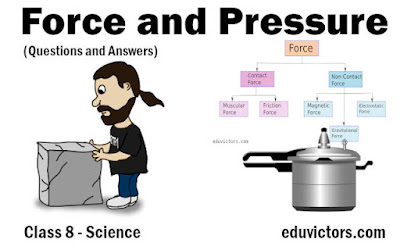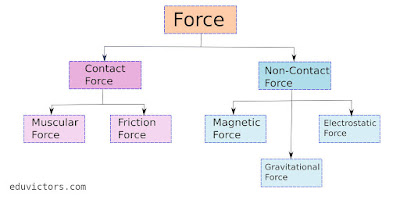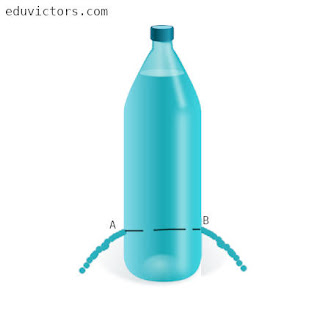Class 8 - Science - Force and Pressure (Questions and Answers)
Q1. State the effects of force.
Answer: Force may:
➀ make an object move from rest.
➁ change the speed of a moving object.
➂ change the direction of motion of an object.
➃ change the shape of an object.
➄ stop a moving object
Q2. Calculate the pressure exerted by a force of 100 N on an area of 4 m²
Answer:
Given,
F = 100 N
A = 4m²
P = $\frac{force}{area}$
= $\frac{100}{4}$ = 25 Pa
Q3. Define force. Write its SI unit.
Answer: A push or a pull that changes or tends to change the state of rest or of uniform motion of an object or changes its direction or shape.
A force arises due to the interaction between two objects. Force has magnitude as well as direction.
The SI unit of force is the newton.
Q4. What is the relation between the direction of the force of friction and the direction of motion?
Answer: The direction of the force of friction is always opposite to the direction of motion of an object.
Q5. Caterpillar tracks are used in battle tanks instead of tyres. Explain.
Answer: Pressure is inversely proportional to area. More is the area, the force being the same, pressure applied will be less. So, the tanks can carry heavy loads.
Q6. Why do some people suffer from nose bleeding at high altitudes?
Answer: Atmospheric pressure decreases at high altitudes. So, as we move to higher altitudes, our inside blood pressure becomes more than the atmospheric pressure. Therefore, some of the blood vessels in our body burst and nose bleeding can occur.
Q7. What are the two states of motion?
Answer: An Object can be in two states.
(a) Rest State: When an object is not moving. This means a stationary object is said to be in a state of rest. For example –A ball and book are kept over the ground and not moving.
(b) Motion State: A moving object is said to be in the state of motion. For example – a moving car, a moving ball, etc.
Q8. How force can change the state of motion? Give examples.
Answer: A Force can move a stationary object. A force can speed up, decrease the speed and change the direction of a moving object. Force can stop a moving object. Finally, we can say that force can change the state of motion.
Examples are:
1. A boy wants to move a tyre faster; it has to be pushed repeatedly.
2. Push a moving ball by hand.
3. In the cricket game, a batsman can push a fast-moving ball in the same direction or opposite direction or change the direction of the movement of the ball.
Q9. Can force change the shape of an object? Explain with an example.
Answer: When you apply force on an inflated balloon by pressing it using your hand from both sides, then the force changes the shape of a balloon.
Similarly, you can change the shape of a rubber band, sponge and spring by stretching them in opposite directions.
Q10. Why is a force called a vector quantity?
Answer: Force is a vector quantity because it has both magnitude and direction. The measurement of strength and amount of force is called the magnitude of force.
Two or more forces on the same object can be applied in the same direction or opposite directions.
Q11. What happens when two or more forces are applied over an object in the same direction?
Answer: When two or more forces are applied in the same direction, then the total or net force is the addition of magnitude of both the forces.
Example: When two persons push the box in the same direction with the magnitude of forces of each 2 N, then the resultant force will be
Net force = - 2N + 2N= 4N (In the direction of applied force)
Q12. What is the resultant force when two forces are applied over an object in the opposite direction?
Answer: When two forces are applied over an object in the opposite directions, the total effective or net force is the difference of magnitude between the two forces.
Q13. What is a contact force? What is its type?
Answer: Contact Force: Force which arises when two bodies are in contact with each other.
e.g.: Muscular force, Frictional force
Q14. What is a muscular force? Give two examples of muscular force.
Answer: Force due to the action of muscles is called muscular force. Muscular force is applied only after interaction with the object.
Examples:
(a) When we push an object like a school bag or lift a bucket of water, we use the muscular force.
(b) Animals also use muscular force to carry out their task. eg Pull a cart
Q15. What is a frictional force? What are the properties of a frictional force?
Answer: The force of friction arises between the surfaces of two objects. The Force of friction comes into action only after interaction between two objects.
Properties:
1. It is a contact force.
2. It always acts in the opposite direction.
3. It is a self-adjusting force.
4. It is a limiting force.
Q16. Give two examples of frictional force.
Answer: Examples are:
(a) Due to the force of friction between the surface of the ball and the ground the moving ball comes to rest.
(b)When we stop pedalling a bicycle, it gradually slows down and finally comes to stop due to the force of friction.
Q17. What is a non-contact force? What are its types?
Answer: It is a force which arises when two bodies are not in contact with each other.
Magnetic force, Electrostatic force and Gravitational force are the types of non-contact forces.
Q18. What is a magnetic force? Give an example.
Answer: A magnet can exert a force on another magnet without being in contact with it.
Example: Opposite poles of two magnets attract each other and the same poles repel each other.
Q19. What is an electrostatic force?
Answer: Force exerted by a charged body on another charged or uncharged body is called electrostatic force.
A charged body attracts an uncharged body.
A positively charged body attracts a negatively charged body and repels a positively charged body without coming in contact.
Q20. What is a gravitational force? Give examples.
Answer: Gravitational force is exerted by the earth, moon, sun and other planets on each other.
Earth and other planets attract all the objects towards them. Since, the earth attracts all the objects even without coming in contact, thus the gravitational force is a non-contact force. Example: When we release an object from a height, it falls over the ground because of the gravitational attraction of the earth.
Q21. Does gravitational force exist between any two objects, say between a pen and a book lying on a table? If yes, why does the pen not move?
Answer: Yes, the gravitational force exists between any two objects. The pen or the book does attract each other but the amount of force of attraction between the two is extremely small (almost negligible). That's why these objects do not move. To see the effect of gravitational force, we need objects as big as our planets.
Q22. Why is it easier to hammer a sharp nail?
Answer: As we know that pressure is inversely proportional to area. Therefore, the lesser the area, the more the pressure exerted. So, it becomes easy to hammer that nail. That is the reason sharp nails are preferred over blunt nails.
Q23. Do fluids exert pressure on the walls of the container?
Answer: Yes, fluids (liquids and gases) exert pressure on the walls of the container in which they are put.
Q24. How can you prove that pressure is exerted by liquids?
Answer: Take a clear glass tube as an example. The tube should be roughly 15 cm long. Take a thin sheet of excellent rubber and cut it into a shape. Stretch the rubber over one end of the pipe and secure it tightly. Maintain a vertical posture for the tube. Fill it with water. The rubber sheet swells. The bulging is caused by the water's pressure.
As a result, it establishes that pressure is exerted by liquids. At any point, pressure is exerted equally in all directions.
Q25. In an activity, three holes A, B and C are made in a plastic bottle, filled with water. Why does the water splashing from hole C reaches maximum height?
Answer: The pressure that a liquid exerts on the bottom of the container is dependent upon the height of the liquid in the container. Pressure increases with depth.
Q26. What is the atmosphere?
Answer: The envelope of air surrounding the earth is known as the atmosphere.
Q27. What is atmospheric pressure?
Answer: Our atmosphere is made of different types of gases. Since gases exert pressure, thus pressure exerted by air is called atmospheric pressure.
Q28. What is the approximate weight of the air of area 15cm x 15cm and the column height of the atmosphere? Why do we not feel this weight or pressure?
Answer: 225 Kg (approx). The reason we are not crushed under this weight is that the pressure inside our bodies is also equal to the atmospheric pressure and cancels the pressure from outside.
Q29. Suggest an activity to get an idea about the magnitude of atmospheric pressure?
Answer: The following experiment can be used to determine the magnitude of atmospheric pressure. Take a high-quality rubber sucker for example. On a smooth plane surface, press it firmly. Most of the air between the sucker's cup and the surface escapes as we press it. Because of the pressure of the atmosphere, the sucker sticks to the surface. The sucker should be pulled off the surface with a lot of force. This activity will give you a sense of atmospheric pressure magnitude.
Q30. As shown in the activity below, there are two holes A and B at the same height in a water-filled bottle. Why does the water flowing out reach the same distance?
Answer: It is because a liquid exerts equal pressure at the same depth.
👉See Also:
Ch 11 - Force and Pressure (Q & A)
Ch11 - Force and Pressure (MCQs)Ch 11 - Force (What is Inertia?)
Ch 11 - Force and Pressure (Assignment Sheet)
Ch 11 - Force and Pressure (Worksheet)
Force, Pressure and Friction (Short Q & A)
Force, Pressure and Friction (MCQs)




No comments:
Post a Comment
We love to hear your thoughts about this post!
Note: only a member of this blog may post a comment.